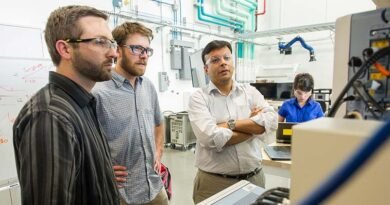New carbon material sets energy-storage record, likely to advance supercapacitors
Leveraging machine learning, chemists at Oak Ridge National Laboratory, under the Department of Energy, pioneered a carbonaceous supercapacitor material that outperforms existing commercial counterparts, storing four times more energy. This breakthrough material, guided by data-driven techniques, holds promise for enhancing regenerative brakes, power electronics, and auxiliary power supplies.
“Combining data-driven methodologies with our expertise, we engineered a carbon material with significantly improved physicochemical and electrochemical properties, pushing the boundaries of energy storage in carbon supercapacitors,” explained Tao Wang, a chemist from ORNL and the University of Tennessee, Knoxville.
Wang led the study titled “Machine-learning-assisted material discovery of oxygen-rich highly porous carbon active materials for aqueous supercapacitor,” published in Nature Communications, alongside chemist Sheng Dai of ORNL and UTK.
Dai emphasized, “This marks the highest recorded storage capacitance for porous carbon—a significant milestone.”
The research, conducted at the Fluid Interface Reactions, Structures, and Transport Center (FIRST), a DOE Energy Frontier Research Center active until 2022, focused on understanding fluid-solid interface reactions influencing capacitive electrical energy storage. Capacitance, crucial for storing electrical charge, was a pivotal aspect.
In the realm of energy storage devices, batteries are conventional, converting chemical energy to electrical energy proficiently. However, capacitors store energy differently, using an electric field akin to static electricity. While they can’t store as much energy as batteries, they excel in quick recharge cycles without losing their charge capacity. Supercapacitors, like those in electric buses, can store more charge and discharge faster than batteries.
The study harnessed machine learning, an AI learning from data to optimize outcomes, to steer the discovery of this exceptional material. Predictions from an artificial neural network model constructed by Runtong Pan, Musen Zhou, and Jianzhong Wu from the University of California, Riverside, a FIRST partner university, set a target: develop an optimal “dream material” for energy delivery.
Their model forecasted that a carbon electrode co-doped with oxygen and nitrogen could achieve a capacitance of 570 farads per gram—the highest envisioned.
Wang and Dai devised an intricately porous doped carbon, maximizing interfacial electrochemical reactions. Wang then synthesized the innovative material—an oxygen-rich carbon framework for efficient charge storage and transport.
The carbon underwent activation to generate more pores and integrate functional chemical groups for oxidation or reduction reactions. Unlike industrial processes that use high temperatures driving oxygen from the material, Dai’s method, developed five years prior, utilized a lower temperature with sodium amide as the activation agent. This approach preserved functional groups better.
Also Read About –
Portland Nuclear Power Startup NuScale hit with Investor Lawsuit
The synthesized material exhibited a capacitance of 611 farads per gram—four times higher than standard commercial material. Notably, pseudocapacitance from continuous, rapid, and reversible oxidation-reduction reactions at oxygen/nitrogen sites contributed significantly to the overall capacitance. The material’s surface area surpassed 4,000 square meters per gram, setting a new record.
The success came rapidly, within three months, thanks to the data-driven approach, streamlining a process that previously would have taken at least a year.
“We’ve reached the pinnacle in carbon material performance,” Wang remarked. “Machine learning’s target-setting prevented us from endlessly optimizing materials without knowing their limits.”
Critical to their success was achieving two pore types—mesopores (2-50 nanometers) and micropores (<2 nanometers). Experimental analyses revealed that this combination not only maximized surface area for energy storage but also facilitated electrolyte transport pathways. Miaofang Chi and Zhennan Huang at the Center for Nanophase Materials Sciences, an ORNL DOE Office of Science user facility, utilized scanning transmission electron microscopy to characterize mesopores, while the tinier micropores were too minute for direct observation.
Microscopically resembling a golf ball with deep dimples, the material’s dimples represented mesopores, with micropores scattered in-between.
“You’re constructing an ion transport highway,” Dai explained. “Our designed structure comprises larger pores, acting as superhighways, connected to smaller roads—the tinier pores.”
“The smaller pores offer more surface for charge storage, while the larger ones act as highways, enhancing charge/discharge rates,” added Wang. “The optimal performance comes from a balanced mix, as predicted by our neural network model.”
To assess electrolyte transport in carbon pores, Murillo Martins and Eugene Mamontov at the Spallation Neutron Source, another ORNL DOE Office of Science facility, utilized quasielastic neutron scattering. Wang described it as “tracking speed on the highway,” marking the first use of neutron scattering to analyze sulfuric acid electrolyte diffusion in confined carbon nanopores. Results showcased varying speeds: swift in mesopores and slower in micropores.
Via modified step potential electrochemical spectroscopy, Wang quantified capacitance contributions from pores of different sizes and oxidation-reduction reactions at their surfaces, a technique limited to a few global facilities. “We found that oxygen and nitrogen-doped mesopores contributed most to overall capacitance,” Wang revealed.
The FIRST team conducted additional studies on physicochemical properties. Using nuclear magnetic resonance, Jinlei Cui and Takeshi Kobayashi from Ames National Laboratory analyzed polymer precursor structures. Raman analysis by Bishnu Thapaliya of ORNL and UTK unveiled the carbon’s disordered structure.
Zhenzhen Yang of UTK and ORNL, alongside Juntian Fan of UTK, contributed to surface area measurements.
This breakthrough research holds promise for expediting the development and optimization of carbon materials for supercapacitor applications. While this study utilized the best available data, scientists now possess additional boundary data, enhancing the machine learning model for subsequent studies.
“With more data, we can establish new targets, pushing the boundaries of carbon supercapacitors even further,” Wang affirmed. “The successful integration of machine learning in material design underscores the potency of data-driven approaches in technological advancement.”
Source – https://phys.org/




